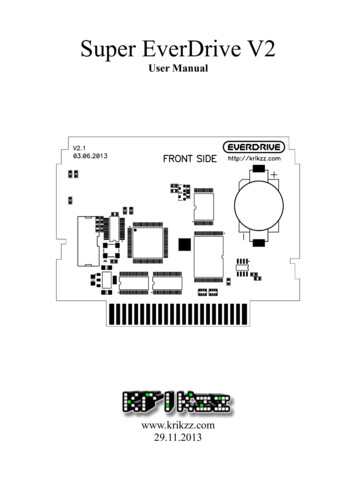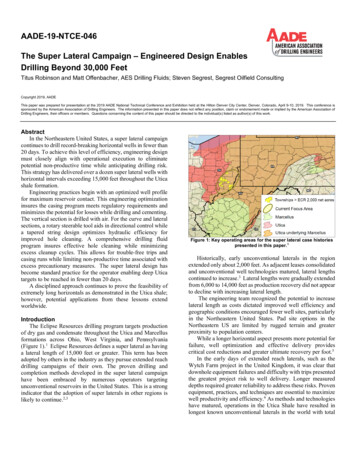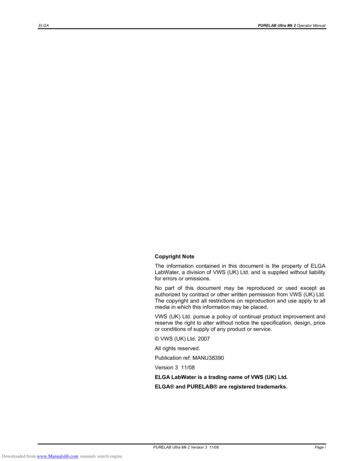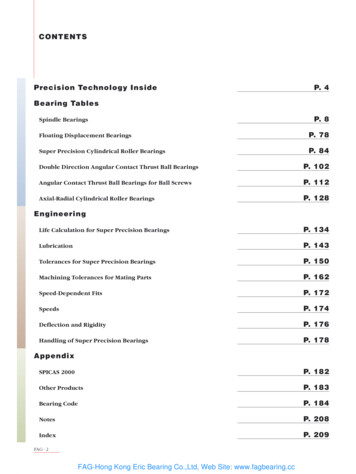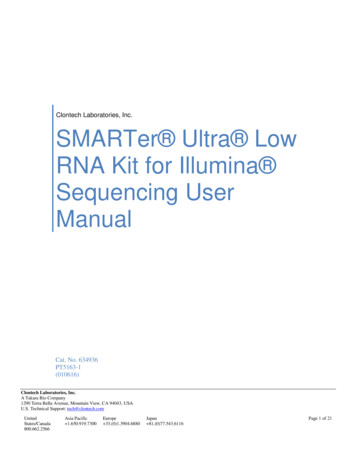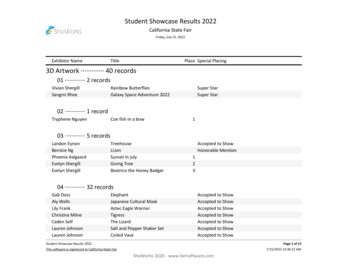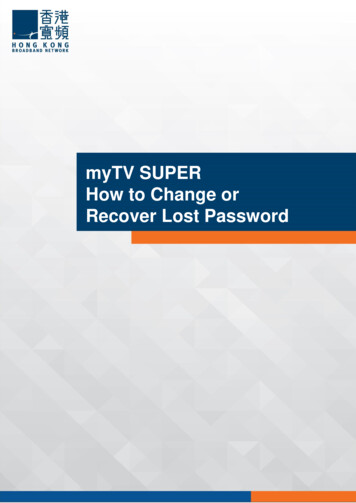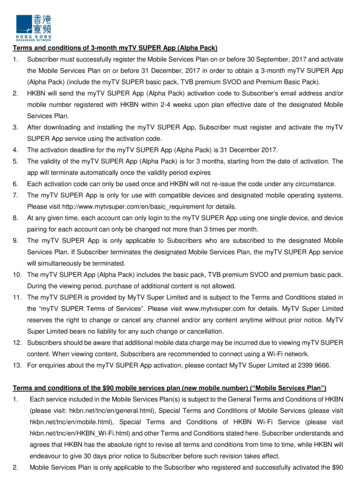
Transcription
ZOE-M8BUltra-small, super low power u-blox M8 GNSS SiP moduleSystem integration manualAbstractThis manual provides hardware and system design instructions for the u-blox ZOE-M8B GNSS SiPmodule.www.u-blox.comUBX-17045131 - R07C1-Public
ZOE-M8B - System integration manualDocument informationTitleZOE-M8BSubtitleUltra-small, super low power u-blox M8 GNSS SiP moduleDocument typeSystem integration manualDocument numberUBX-17045131Revision and dateR07Disclosure restrictionC1-PublicDocument statusProduction information14-Oct-2021Product statusCorresponding content statusIn Development /PrototypeObjective SpecificationTarget values. Revised and supplementary data will be published later.Engineering SampleAdvance InformationData based on early testing. Revised and supplementary data will be published later.Initial ProductionEarly Production InformationData from product verification. Revised and supplementary data may be published later.Mass Production /End of LifeProduction InformationDocument contains the final product specification.European Union regulatory complianceZOE-M8B complies with all relevant requirements for RED 2014/53/EU. The ZOE-M8 Declaration of Conformity (DoC) isavailable at www.u-blox.com within Support Product resources Conformity Declaration.This document applies to the following products:Product nameType numberROM versionPCN referenceZOE-M8BZOE-M8B-0-11ROM SPG 3.51UBX- 21030535u-blox or third parties may hold intellectual property rights in the products, names, logos and designs included in thisdocument. Copying, reproduction, modification or disclosure to third parties of this document or any part thereof is onlypermitted with the express written permission of u-blox.The information contained herein is provided “as is” and u-blox assumes no liability for its use. No warranty, either express orimplied, is given, including but not limited to, with respect to the accuracy, correctness, reliability and fitness for a particularpurpose of the information. This document may be revised by u-blox at any time without notice. For the most recentdocuments, visit www.u-blox.com.Copyright u-blox AG.UBX-17045131 - R07Production informationPage 2 of 43Document information
ZOE-M8B - System integration manualContentsDocument information . 2Contents . 31Hardware description . 61.1 Overview . 61.2 Low power operation . 621.2.1Super-E mode overview . 61.2.2Super-E mode power consumption . 7Design-in . 122.1 Power management .122.1.1Overview .122.1.2Power modes .122.2 Communication interfaces .152.2.1UART interface .152.2.2Display data channel (DDC) interface.162.2.3SPI interface .162.2.4SQI interface .162.3 I/O pins .172.3.1External interrupt .172.3.2External LNA enable .172.3.3Electromagnetic interference and I/O lines .172.4 Real-time clock (RTC) .182.4.1RTC using a crystal.182.4.2RTC using an external clock .182.4.3Time aiding .182.5 RF input .182.5.1Passive antenna .192.5.2Active antenna .202.6 Safe boot mode (SAFEBOOT N) .202.7 System reset (RESET N) .202.8 Pin description .212.9 Typical schematic .232.10 Migration from ZOE-M8G to ZOE-M8B.232.11 Design-in checklist.242.11.1 General considerations .242.11.2 Schematic design-in for ZOE-M8B GNSS SiP .242.12 Layout design-in checklist .242.13 Layout .252.13.1 Footprint .252.13.2 Paste mask .262.13.3 Placement .26UBX-17045131 - C1-PublicProduction informationPage 3 of 43Contents
ZOE-M8B - System integration manual2.13.4 Layout design-in: Thermal management .262.14 EOS/ESD/EMI precautions .262.14.1 Electrostatic discharge (ESD) .262.14.2 ESD protection measures .272.14.3 Electrical overstress (EOS) .272.14.4 EOS protection measures .272.14.5 Electromagnetic interference (EMI) .272.14.6 Applications with cellular modules .283System integration . 313.1 Backup and time aiding for power off .313.2 Using multi-GNSS Assistance (MGA) .323.2.1AssistNow Online.323.2.2AssistNow Offline (ANO) .333.2.3AssistNow Autonomous .333.3 Data batching .334Product handling and soldering . 354.1 Packaging, shipping, storage and moisture preconditioning .354.2 ESD handling precautions .354.3 Safety precautions .354.4 Soldering .3654.4.1Soldering paste .364.4.2Reflow soldering .364.4.3Optical inspection .364.4.4Repeated reflow soldering .364.4.5Wave soldering .364.4.6Rework .364.4.7Use of ultrasonic processes .36Product testing . 375.1 Test parameters for OEM manufacturer .375.2 System sensitivity test .375.2.1Guidelines for sensitivity tests .375.2.2“Go/No go” tests for integrated devices .37Appendix . 38AGlossary . 38BRecommended components . 39B.1 External RTC (Y1) .39B.2 RF bandpass filter (F1) .39B.3 Optional SQI flash (U3).40B.4 External LNA (U1) .40B.5 RF ESD protection diode.40B.6 Ferrite beads (FB1) .40B.7 Feed-through capacitors .41UBX-17045131 - C1-PublicProduction informationPage 4 of 43Contents
ZOE-M8B - System integration manualB.8 Standard capacitors .41Related documents . 42Revision history . 42Contact . 43UBX-17045131 - C1-PublicProduction informationPage 5 of 43Contents
ZOE-M8B - System integration manual1Hardware description1.1 OverviewThe u-blox ZOE-M8B standard precision GNSS SiP module features the high-performance u-blox M8GNSS engine. The ultra-miniature form factor integrates a complete GNSS receiver solution includingSAW filter, LNA and TCXO.The ZOE-M8B GNSS SiP is targeted for applications that require a small size without compromisingthe performance. It features the new Super-Efficient (Super-E) operation mode, providing a uniquebalance between power consumption and performance.For RF optimization, the ZOE-M8B SiP integrates a front-end SAW filter and an additional front-endLNA for increased jamming immunity and easier antenna integration. The Super-E mode allowsautomatic LNA duty-cycling for reduced power consumption. A passive antenna can be used toprovide a highly integrated system solution with minimal eBOM.The ZOE-M8B optimizes the overall system power consumption by excluding the need for any heavysignal processing on the application processor. In the Super-E mode, the system can operate withabsolute minimal current consumption during power-optimized periods. Navigation data can bestored internally while the application processor is in deep sleep (data batching). Super-E mode, LNAduty cycling, and intelligent power management are breakthroughs for low-power applications.The ZOE-M8B GNSS SiP can be easily integrated in manufacturing thanks to the advanced S-LGA(Soldered Land Grid Array) packaging technology, which enables easier and more reliable solderingprocesses compared to a normal LGA (Land Grid Array) package. For product features see the ZOE-M8B Data sheet [1]. To determine which u-blox product best meets your needs, see the product selector tables on theu-blox website www.u-blox.com.1.2 Low power operationThe ZOE-M8B GNSS SiP is designed for use in portable and wearable applications. It is intended torun in Super-E mode and defaults to this mode on power up. The Super-E mode provides the bestbalance between current consumption vs. performance. The Super-E mode also enables automaticduty cycling of both the internal and optional external LNA to further lower the total powerconsumption.For specific power saving applications, the host processor has an option to put the receiver intobackup state. All essential data for quick re-starting of navigation can be saved either on the receiverside or on the host processor side.The data batching feature allows position fixes to be stored in the RAM of the GNSS receiver for laterretrieval in one batch. Batching of position fixes happens independently of the host system, and cancontinue while the host is powered down with as many as 300 sets of position, accuracy estimate,speed, and time data.Used in combination with multi-GNSS Assistance data, the ZOE-M8B GNSS SiP not only features fastTTFF and good sensitivity, but also ensures minimal power consumption, since A-GNSS enables thechip to maximize its power-optimized period.1.2.1 Super-E mode overviewSuper-E mode provides optimal power savings while maintaining good level of position and speedaccuracy. ZOE-M8B defaults to Super-E mode on power up.UBX-17045131 - C1-PublicProduction informationHardware descriptionPage 6 of 43
ZOE-M8B - System integration manualOn receiver startup, the Super-E mode uses the acquisition engine until a sufficient number ofsatellites is acquired for reliable GNSS performance, and uses the tracking engine to track thesatellites. By default, the acquisition engine is active at least for 5 minutes after the receiver startupto read the ephemeris of many satellites. The tracking engine is duty-cycled adaptively according tothe signal strength in order to provide the best balance between power consumption and navigationperformance.Super-E mode offers choice of 1 Hz (default), 2 Hz, or 4 Hz operation. In addition, a slower operationrate with an interval of 1 – 10 s can be selected. The higher 2 Hz and 4 Hz navigation rates improvethe navigation accuracy, but they also consume more power. The power mode can be selected withthe configuration message UBX-CFG-PMS. Update periods longer than 1 s are set with the ExtendedPower Management configuration message UBX-CFG-PM2.Super-E mode has two settings to tune the receiver operation. The “performance” (default) settingprovides the best balance for power vs. performance. The “power save” setting provides up to anadditional 15-20% power savings at the cost of position accuracy. The setting can be selected withthe optTarget configuration option of the Extended Power Management configuration message UBXCFG-PM2.During the tracking phase of the Super-E mode, the satellite reception is duty-cycled and it is turnedoff most of the time. The receiver reads data from the satellite transmission only occasionally. Mostlyit just checks where the tracked satellites are at that time, and then calculates the position. Withstrong enough signal strength, the active time is 1/12 of each navigation cycle. If signal level goes toolow, the active time can go up to 1/3 of each navigation cycle.Optimal efficiency of Super-E mode is achieved with a strong signal level. To ensure best efficiency,significant power savings, and good tracking performance, the signal strength of the strongestsatellites should be at least -146 dBm to -144 dBm (C/N0 value of 28 dBHz to 30 dBHz). Super-E modewill still work if the signal level goes lower, but efficiency will then degrade.Some satellites become obscured every now and then when the receiver moves. In Super-E mode, thereceiver needs to be able to track at least 6 - 8 satellites constantly. If some of the currently usedsatellites are not in view, the receiver can start to use some other known satellite. If too many of thecurrently known satellites are obscured, the receiver must restart the acquisition engine and stoppower-optimized tracking to read ephemeris data for the new satellites. This acquisition phase lastsonly as long as minimally needed.Navigation performance improves if ephemeris of many more satellites is known beforehand, becausethe receiver can then use new satellites even if several of the previously used satellites are out of view.The five-minute (default) initial acquisition period on receiver startup helps to read the ephemeris ofmany satellites. Ephemeris data can be provided to the receiver also with AssistNow mechanism. Ifthe ephemeris data for many satellites are known, then there is no need to read this data from thesatellite transmission. Such preloading of data improves performance especially when the receiver isstarted in a low signal level environment (for example, indoors). The initial acquisition period can beadjusted with the Extended Power Management configuration message UBX-CFG-PM2. Theminimum value for an initial acquisition period is 0 s, which can be used if, for example, valid AssistNowOnline data or up to one-day old AssistNow Offline data are available. Depending on the age of theaiding data and GNSS signal conditions, an initial acquisition period up to two or three minutes maybe beneficial.1.2.2 Super-E mode power consumption1.2.2.1 Super-E statesZOE-M8B defaults to the Super-E mode on powerup. The receiver starts up in the full-poweracquisition state to search for satellites. The acquisition state continues until there is a valid 3D fixUBX-17045131 - C1-PublicProduction informationHardware descriptionPage 7 of 43
ZOE-M8B - System integration manualand the receiver has enough information about available satellites. For the 3D fix, the receiver needsto receive data for current GNSS time and information of at least four satellites (red points in Figure1). The receiver continues searching for more satellites in the acquisition state (yellow dots in Figure1) until it has enough information for proper low-power operation. By default, this search lasts for fiveminutes after the receiver start-up, but can be adjusted if, for instance, AssistNow data is used.After the initial acquisition state, the receiver enters the power-optimized tracking state (shown bythe green dots in Figure 1). This is the low-power state of the Super-E mode. If the set of availablesatellites gets too small, the receiver again enters acquisition or tracking state for a short period untilit has enough satellites to track. This is shown by the brief peaks in current consumption during thepower-optimized tracking state in Figure 1.The state of the receiver is given in the psmState field in the UBX-NAV-PVT message.Figure 1: Current consumption in different states in Super-E mode.1.2.2.2 Super-E power consumption examplesThe sensitivity, accuracy, and power efficiency of a GNSS receiver depend heavily on the availability,strength and quality of the GNSS signal. If the signal is attenuated, blocked or reflected, the powerconsumption, acquisition speed, and positioning accuracy suffer. Application design, includingantenna performance, also contributes to the signal quality. Use of assistance often helps to improveboth performance and power consumption.In the following examples, current consumption in Super-E mode is shown for open, forest and urbanenvironment over a 30-minute period. The results are presented for the default mode, that is, 1 HzSuper-E “performance” setting with GPS, GLONASS and QZSS enabled. A wrist-worn sports watchwith weak and constantly changing reception was used to receive the GNSS signal.Current consumption in an open environment is shown in Figure 2 and Figure 3 for continuous andSuper-E mode, respectively. The average tracking current in continuous mode is 45.7 mA whereas inSuper-E mode the average current drops to 13.3 mA after the (adjustable) initial acquisition period.Use of assistance improves TTFF but also further reduces average current consumption byapproximately 15% (Figure 4).The effect of environment on current consumption can be seen in Figure 3 (open), Figure 5 (forest)and Figure 7 (urban). The power optimization in Super-E mode performs best in an open environment,with the current consumption increasing with deteriorating signal conditions. Under heavy multipathand blocking of satellites, the receiver may need to briefly exit power-optimized tracking to acquireUBX-17045131 - C1-PublicProduction informationHardware descriptionPage 8 of 43
ZOE-M8B - System integration manualnew satellites. The use of assistance improves TTFF and reduces current consumption in all cases(as seen in Figure 4, Figure 6 and Figure 8).Figure 2: ZOE-M8B continuous mode current consumption in open environmentFigure 3: ZOE-M8B Super-E mode current consumption in open environmentFigure 4: ZOE-M8B Super-E mode current consumption in open environment with AssistNow OfflineUBX-17045131 - C1-PublicProduction informationHardware descriptionPage 9 of 43
ZOE-M8B - System integration manualFigure 5: ZOE-M8B Super-E mode current consumption in obstructed environment (forest)Figure 6: ZOE-M8B Super-E mode current consumption in obstructed environment (forest) with AssistNow OfflineFigure 7: ZOE-M8B Super-E mode current consumption in urban environmentUBX-17045131 - C1-PublicProduction informationHardware descriptionPage 10 of 43
ZOE-M8B - System integration manualFigure 8: ZOE-M8B Super-E mode current consumption in urban environment with AssistNow OfflineUBX-17045131 - C1-PublicProduction informationHardware descriptionPage 11 of 43
ZOE-M8B - System integration manual2Design-inTo obtain good performance with the ZOE-M8B GNSS SiP, there are a number of issues requiringcareful attention during the design-in. These include: Power supply: Good performance requires a clean and stable power supply. Interfaces: Ensure correct wiring, rate and message setup on the SiP and your host system. Antenna interface: For optimal performance, seek short routing, matched impedance and nostubs.2.1 Power management2.1.1 OverviewThe ZOE-M8B GNSS SiP provides two supply pins: VCC and V BCKP. They can be suppliedindependently or tied together, depending on the intended application.2.1.1.1 Main supply voltage (VCC)During operation, the ZOE-M8B GNSS SiP receives power through the VCC pin. Built-in LDOs generatestabilized voltages for the core and RF domains of the chip. The current at VCC depends heavily onthe current state of the system and is in general very dynamic. Do not add any series resistance ( 0.1 Ω) to the VCC supply, as it will generate input voltage noisedue to the dynamic current conditions.The digital I/Os of the ZOE-M8B GNSS SiP are supplied by the VCC voltage.2.1.1.2 Backup power supply (V BCKP)In the case of a power failure at main supply VCC, the backup domain and optional RTC oscillator aresupplied by V BCKP. Providing a V BCKP supply maintains the time (RTC) and the GNSS orbit datain backup RAM. This ensures that any subsequent re-starts after a VCC power failure will benefit fromthe stored data, providing a faster TTFF.The GNSS satellite ephemeris data is typically valid for up to 4 hours. To enable hot starts, ensurethat the battery or capacitor at V BCKP is able to supply the backup current for at least 4 hours. Forwarm starts or when using the AssistNow Autonomous, the V BCKP source must be able to supplycurrent for up to a few days If no backup supply is available, V BCKP can be connected to reserved neighbor pin G9. Avoid high resistance on the V BCKP line: During the switch from main supply to backup supply,a short current adjustment peak can cause high voltage drop on the pin with possiblemalfunctions. For description of the different power operating modes see the ZOE-M8B Data sheet [1].2.1.2 Power modesThe ZOE-M8B GNSS SiP can operate in two power modes: Super-E Mode to optimize power consumption (default mode) Continuous mode for best GNSS receptionThe available power modes are illustrated in Figure 9. The Super-E Mode has three predefinedsettings for 1 Hz (default), 2 Hz and 4 Hz update rates. In addition, Super-E mode supports longerUBX-17045131 - C1-PublicProduction informationDesign-inPage 12 of 43
ZOE-M8B - System integration manualuser-defined update periods from 1 s up to 10 s. The continuous mode has two predefined settings,full power and balanced.For specific power saving applications, the host system has an option to put the receiver into backupstate. All essential data for quick re-starting of navigation can be saved either on the receiver or onthe host processor side. Unlike some other u-blox M8 receivers, the ZOE-M8B GNSS SiP does not support self-managedON/OFF power saving mode, in which the receiver period
The ZOE-M8B GNSS SiP is targeted for applications that require a small size without compromising the performance. It features the new Super-Efficient (Super-E) operation mode, providing a unique . Super-E mode provides optimal power savings while maintaining good level of position and speed accuracy. ZOE-M8B defaults to Super-E mode on power .

